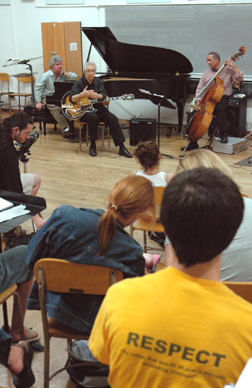The Culture of Jazz Aesthetics
Anthropology 148a: Language and the Culture of Art
World Arts and Culture M124
Ethnomusicology 197, Section 1
Instructors: Profs. Prof. Kenny Burrell and Alessandro Duranti
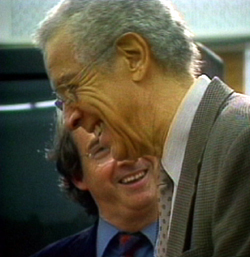 |
Spring 2004 / Tuesday 11-2PM / SMB 1343
Office Hours for Prof. Duranti: Tuesday 3:-4:30 or by appointment (write to: aduranti@anthro.ucla.edu)
Office Hours for Prof. Burrell: Wednesday & Thursday 11:30-12:30
[Updated June 7, 2004 ]
This course looks at the aesthetics of jazz from the point of view of the musicians who shaped jazz as an art form in the 20th century. Students will be expected to integrate readings and their own fieldwork outside of class with their experience in the class, where they will have a chance to hear and interact with professional jazz musicians who will answer questions and give musical demonstrations. The course combines the analytical resources and historical knowledge of musicians and ethnomusicologists with those of linguistic anthropologists interested in jazz as a cultural tradition that reproduces itself through subtle conventions for communicating aesthetic ideas and values.
Each meeting will be divided into two main parts:
- interaction/interviews with guests, i.e. musicians, theorists, historians; and live performance/demonstration by musicians. (Visitors will be allowed in this part of the class)
- lecture/discussion. (Visitors and those students who are not officially enrolled in the class will not be allowed to participate in this part of the class)
Portions of the class, especially the interactions with the guests will be videotaped and archived for future study. NO OTHER RECORDING WILL BE ALLOWED BY STUDENTS OR VISITORS.
Grading:
- Assignments (35%)
- Midterm Group Project (20%)
- Final Project (30%)
- A book review (see below for the list of books you can choose from) (15%).
All assignments and exams (Projects) will be posted on the web (in this page) the day after each class meeting.
Textbooks:
For all students:
- Monson, I. 1996. Saying Something: Jazz Improvisation and Interaction. University of Chicago Press. [Study Questions for Monson's book]
- Sawyer, R. Keith. 2001. Creating Conversations. Improvisation in Everyday Discourse. Hampton Press. [Study Questions for Sawyer's book]
(Optional, for students with no background in music, one of the following two books)
Jerry Coker (1990). How to Listen to Jazz. Revised Edition. New Albany, IN: Aebersold. [concise, with short chapters on formal structures in jazz, the rhythm section, the improvised solo, a few famous players (Armstrong, Coleman Hawkins, Lester Young, C. Parker, Miles Davis, John Coltrane)]
Mark C. Gridley. Jazz Styles. History and Analysis. 7th edition. [A widely used introductory textbook covering jazz from the origins to Jazz-Rock Fusion, with an Appendix on Elements of Music.]
In addition, choose one of the following books and write a review (750 words):
- Ake, David (2002). Jazz Cultures. Berkeley: University of California Press.
- Berliner, P. F. 1994. Thinking in Jazz: The Infinite Art of Improvisation. University of Chicago Press. [Appropriate for music majors, contains musical transcriptions of jazz solos]
- Davis, Miles and Quincy Troupe (1989). Miles: The Autobiography. New York: Simon and Schuster.
- Gourse, Leslie (1997). Straight, No Chaser: The Life and Genius of Thelonious Monk. New York: Simon & Schuster Macmillan.
- Kahn, A. 2000. Kind of Blue: The Making of the Miles Davis Masterpiece. New York: Da Capo Press.
- Nicholson, S. (Ed.) 1998. Jazz-Rock: A History. Shirmer. [Particularly appropriate for students with a background in rock music]
- Nisenson, E. 2000. The Making of Kind of Blue: Miles Davis and His Masterpiece. New York: St. Martin's Press.
- Porter, Eric (2002). What Is This Thing Called Jazz? African American Musicians as Artists, Critics, and Activists. Berkeley: University of California Press.
- Porter, Lewis .1998. John Coltrane: His LIfe and Music. Ann Arbor: The University of Michigan Press.
Week 1: April 6
Jazz is ...: A first encounter with jazz as an art form
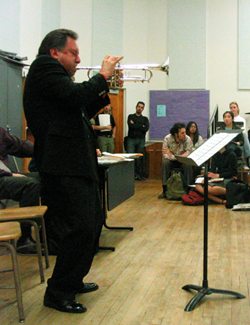 |
Bobby Rodriguez, April 6, 2004. (Photo by Heather Loyd)
Readings distributed in class:
- Mark Levine. Terms, Lingo, Musicians' Nicknames. From The Jazz Piano Book
- Barry Kernfeld. Selected pages on Blues Progression (and Blues in Jazz-Rock and Fusion). In The New Grove Dictionary of Jazz.
- Sheet music from jazz tunes.
Week 2: April 13
The Aesthetics of Improvisation in Jazz
Video Clip (From the first day of Fall 2002 class, Tom Ranier recounts his experience of playing with Buddy DeFranco while discussing improvisation, and the notiong of "being great")
Readings for this week:
- Sawyer, R.K. Ch. 1 "Scripts and Improvisation", pp. 7-41
- Monson, I. Introduction and Chapter One "Talking to Musicians", pp. 1-25.
Special Guest: Kenny Burrell
Week 3: April 20
The Rhythm Section: The Roles of the Instruments and the Attitudes of the Players
Video Clip on "Swing Feel" (From Fall 2002, Sherman Ferguson and Michele Weir explain "Swing Feel")
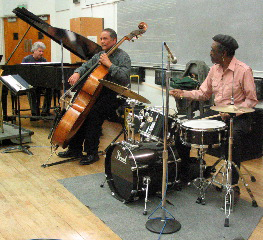 |
Tom Ranier on piano, Roberto Miranda on bass and Sherman Ferguson on drums, on April 20, 2004. (Photo by Heather Loyd)
Readings:
- Monson, I. Ch. 2 "Grooving and Feeling", p. p26-72.
- Sawyer, R.K. Ch. 2 "Dialogues" and Ch. 3 "Audiences" pp. 43-104
- Additional readings may be distributed in class
Special Guests: Sherman Ferguson, Roberto Miranda, and Tom Ranier
Week 4: April 27
The Great Soloists: Imagination, Individualism, and the Ability to Listen
Readings:
- Monson, I. Ch. 3 "Music, Language, and Cultural Styles: Improvisation as Conversation", pp. 73-96.
- Sawyer, R.K. Ch. 4 "Rehearsals", pp. 105-131.
Special Guests: Billy Childs , Hubert Laws, Charles Owens.
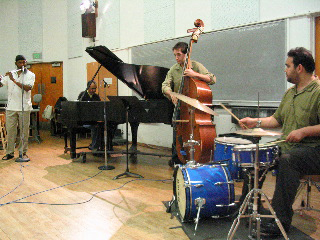 |
Hubert Laws on flute, Billy Childs on piano, Tom Altura on bass and Warren Ontiveros on drums, April 27, 2004. (Photo by Heather Loyd)
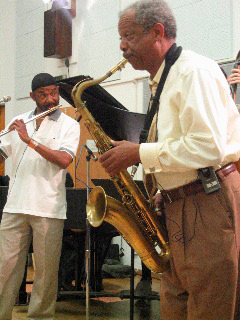 |
Hubert Laws and Charles Owens. (Photo by Heather Loyd)
Week 5: May 4
The Culture of Jazz Aesthetics: An Ethnographic Approach, Part I (lecture by A. Duranti)
Midterm assignment due May 11 at the beginning of class (Description of mid-term assignment)
Readings:
- Sawyer, R.K. Ch. 6 "Settings" pp. 159-183 and Ch. 7 "Performances" pp. 185-210.
Week 6: May 11
The Aesthetics of Jazz Arranging
Readings:
Special Guests: Frank Capp and Gerald Wilson.
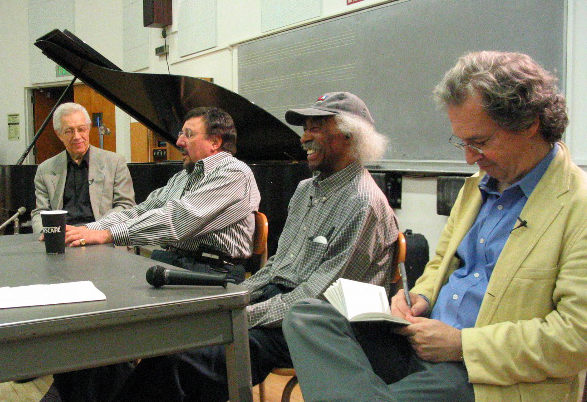 |
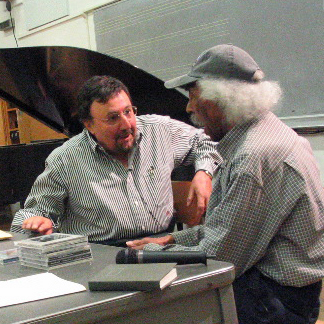 |
Frank Capp and Gerald Wilson discuss orchestration. (Photos by Heather Loyd)
Week 7: May 18
"Cutting It": The Making of a Record that Further Defines the Aesthetics
Readings:
- Monson, I. Ch. 4 "Intermusicality" pp. 97-132.
Special Guests:Louie Bellson (Luigi Paulino Alfredo Francesco Antonion Balassoni) and Frank Capp.
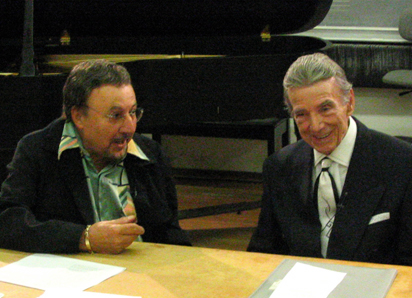 |
(above) Frank Capp and Louie Bellson discuss drumming. (Photos by Heather Loyd)
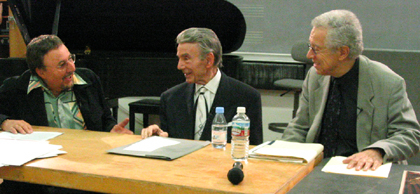 |
Week 8: May 25
The New Generation: Being Socialized into the Jazz Aesthetics
Readings:
- Monson, I. Ch. 5 "Interaction, Feeling, and Musical Analysis", pp. 133-191.
- Ochs, E., and B. B. Schieffelin. 2001 (originally 1984). "Language Acquisition and Socialization: Three Developmental Stories and Their Implications," in Linguistic Anthropology: A Reader. Edited by A. Duranti, pp. 263-301. Blackwell.
Guests: Students in the UCLA Jazz Program, including: Ben Adamson (tpt), Tom Altura (b), Isaac Darche (g), Eliot Deutsch (tpt), Noah Garabedian (b), Jeff Goodkind (p), Warren Ontiveros (d), Joe Petrasek (d), Michael Sheridan (as), Ian Vo (as)
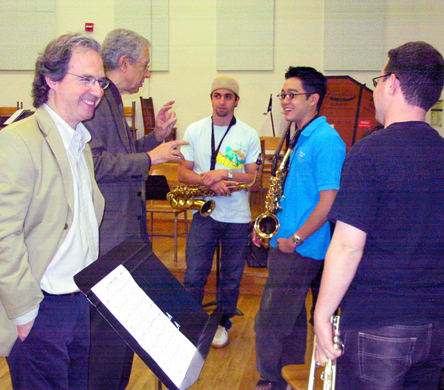 |
A. Duranti and K. Burrell welcome students from the UCLA Jazz Program. (Photo by Heather Loyd)
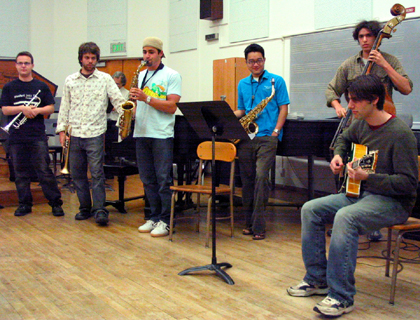 |
Students from the UCLA Jazz Program perform for the class. (Photo by Heather Loyd)
Week 9: June 1
The Language of Jazz: How Jazz Musicians Communicate Musical Ideas through Talk and Other (Meaningful) Means
Readings:
- Monson, I. Ch. 6 "Ethnomusicology, Interaction, and Poststructuralism" + "Coda", pp. 192-218 .
- Howard S. Becker (2000) The Etiquette of Improvisation. Mind, Culture and Activity, vo. 7, pp. 171-76.
Guests: Sherman Ferguson, Roberto Miranda, Barbara Morrison, Tom Ranier.
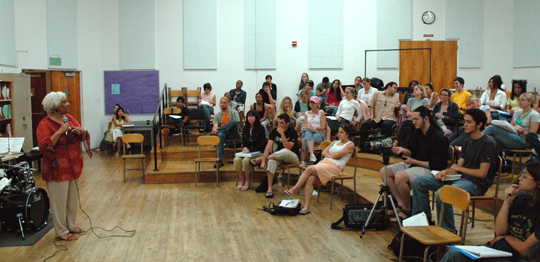 |
Barbara Morrison answers questions from students and (below) Barbara Morrison sings with a great rhythm section (UCLA Jazz Program faculty Tom Ranier, Kenny Burrell, Roberto Miranda and Sherman Ferguson) (photos by Alessandro Duranti).
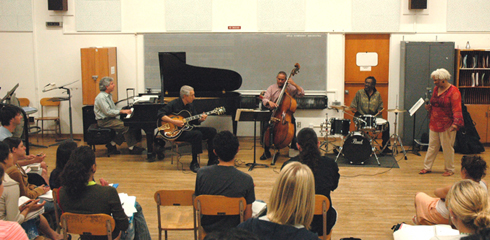 |
Week 10: June 8
The Culture of Jazz Aesthetics: An Ethnographic Approach, Part 2 (lecture by A. Duranti)
Book review due today at the beginning of class. Book Review)
Final Project due Friday June 11, at 11am in the Anthropology main office, Haines 341. (Description of Final Project: Interview)
Readings:
No Special Guests
